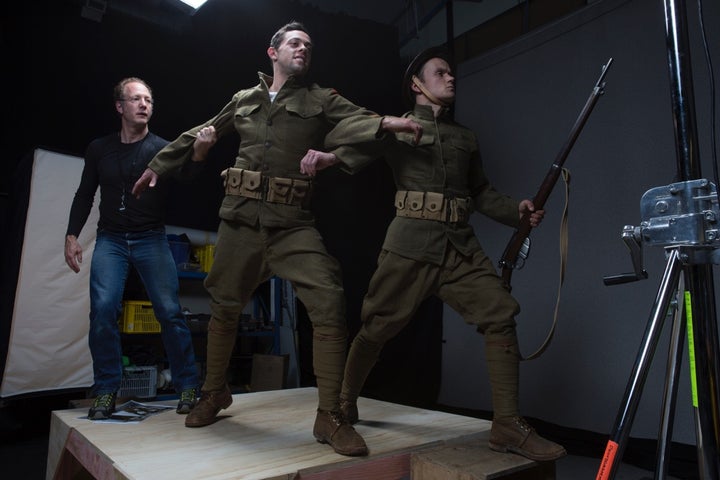In January, 2016, my husband Sabin Howard and his design partner architect-in-training Joe Weishaar won the competition to design and build the National World War I Memorial. The Memorial is slated to stand in Pershing Park, located between the Mall and the White House.
Thus began a wild ride for my husband and our family.
Sabin began the journey with a great deal of cachet in the art world. His skills as a draughtsman and as a sculptor are extraordinary, of a level not seen in a hundred years. But it isn’t just that he can draw and sculpt. He has a talent stack that includes business acumen, an aesthetic sense, charisma, and public speaking. He taught for over a decade; the experience in front of a classroom gave him a flair for showmanship and understandability as a public speaker. He’s also very good looking. (Granted, I’m biased because he’s my husband.) The point is, Sabin can command a room.
When he and Joe won the competition, Sabin already had hundreds more friend requests on FaceBook than FaceBook allows. Although I’m not a fan of this overly-powerful social media platform and I believe that, like Ma Bell in the eighties, it’s a monopoly that should be broken up, FaceBook serves as a metric for something. Popularity, seemingly.
Sabin’s work had also already been reviewed in The New York Times: “Sabin Howard, a sculptor of immense talent, has created some of the most substantive realistic sculpture of the last decade.” (April 28, 2002). He had received numerous other accolades in print, in publications like Fine Art Connoisseur, American Arts Quarterly, and The New Criterion. He was on the map as an artist of note—and his name on the map had a star beside it.
Winning the Memorial Competition catapulted him to a new level of visibility. This memorial is privately funded, and the World War I Memorial Commission works hard to raise the funds to build the Memorial.
I come from a military family and I am passionately devoted to the cause of commemorating veterans and what they’ve done for our country. Creating a memorial of a global, paradigm-changing war that is largely forgotten in our country strikes a chord with me.
People like me, families like my family of origin, men like my dad, made sacrifices. They fought and died and grieved. They returned from World War I profoundly changed. They’d been gassed and blinded; their feet had rotted in the muddy trenches. Many men were shattered beyond repair, even with victory. Sometimes husbands and fathers and sons didn’t return home at all, but simply vanished, their bodies never found.
There is a personal human cost to a war; even 100 years later, that cost deserves to be honored.
In the same way, there is a personal, human cost to making this memorial, and I am writing about it in this series to memorialize that. Artists and their families are people, too.
There’s a fascination around Michelangelo’s tribulations with the Pope, and the World War I Memorial, with its planned 38 figures, is Sabin’s Sistine Chapel.
Sabin threw himself into the task of designing the Memorial according to Joe Weishaar’s plans, which called for a 65’ long bronze wall covered with reliefs. Sabin’s first step was to design and draw the relief. He got actors and our daughters in to his studio to pose.

Sabin Howard in the studio
It’s here that collaborative work began in earnest. Commissioner Edwin Fountain had a vision for a dynamic relief; Sabin’s initial attempts were neo-classical, too serene. Fountain pushed Sabin to revise. I give Fountain credit for this. Pushing Sabin on anything can be like waving a red flag in front of a bull.
Sabin wanted to please Fountain and revised, revised, revised. And Fountain was right about what was necessary. The drawing that emerged at the end of the process is passionate, energized, poignant. Sabin calls it “A Soldier’s Journey” as it tells the story of a soldier leaving his family to go to war, endure the madness and brutality of war, and return home with glory but also with new understanding of the chaos embedded in the human condition.

A Soldier’s Journey - Conceptual Drawing
My father served in the United States Navy during the Cold War, but if he had fought and suffered in World War I, I would be proud of Sabin’s drawing. I would feel that his efforts, and our family’s sacrifices, had been duly respected.
As Sabin drew the relief, the Commission’s efforts to raise funds combined with Sabin’s flair for promotion. Media attention ensued. Fox News came calling. Sabin was filmed in his studio for a “Modern Masters” segment. Sabin’s Instagram account that showcases his work skyrocketed to over 40K followers; as of the writing of this piece, it’s at 56.8K.
The actors who participated in the photography also promoted the Memorial. Artists around the world lauded Sabin’s designs on social media. Hundreds of people, most of them artists though many veterans as well, posted respectful, sometimes gushing comments on various social media platforms.
This is what the current art market, and many art schools, don’t quite grok: people around the world crave excellent art, real art that elevates the spirit, art that is beautiful and that demonstrates the artist’s skill and personal human vision.
In addition to commemorating a war of vast and tragic proportions, the National World War I Memorial will disrupt the current art world assumptions. This is secondary to its purpose, but it adds a special spark to the project.
Beauty, excellence, and the artist’s skill matter—and those qualities serve the intent to memorialize our country’s part in World War I. Hitched to the level of artistry is the narrative aspect of the Memorial. As film does, this relief tells a story that will reach people on a gut level. Noted journalist Milene Fernandez of The Epoch Times calls the relief “a permanent film cast in bronze.”
Part 2 of this series will follow Sabin’s journey to New Zealand, his separation from me and our daughter, and his creation of the 1:6 scale Maquette at the Weta Workshop in beautiful Wellington.
